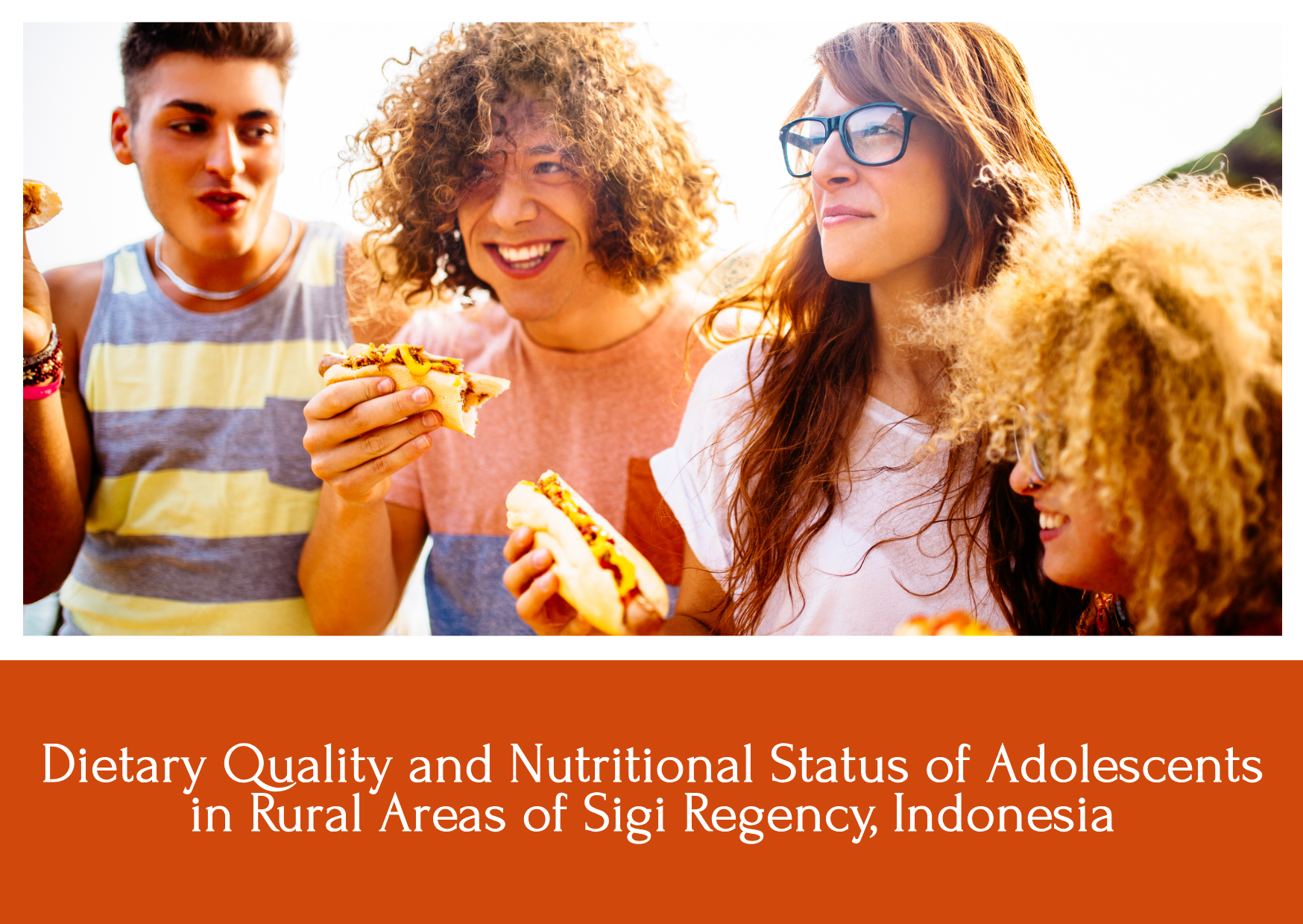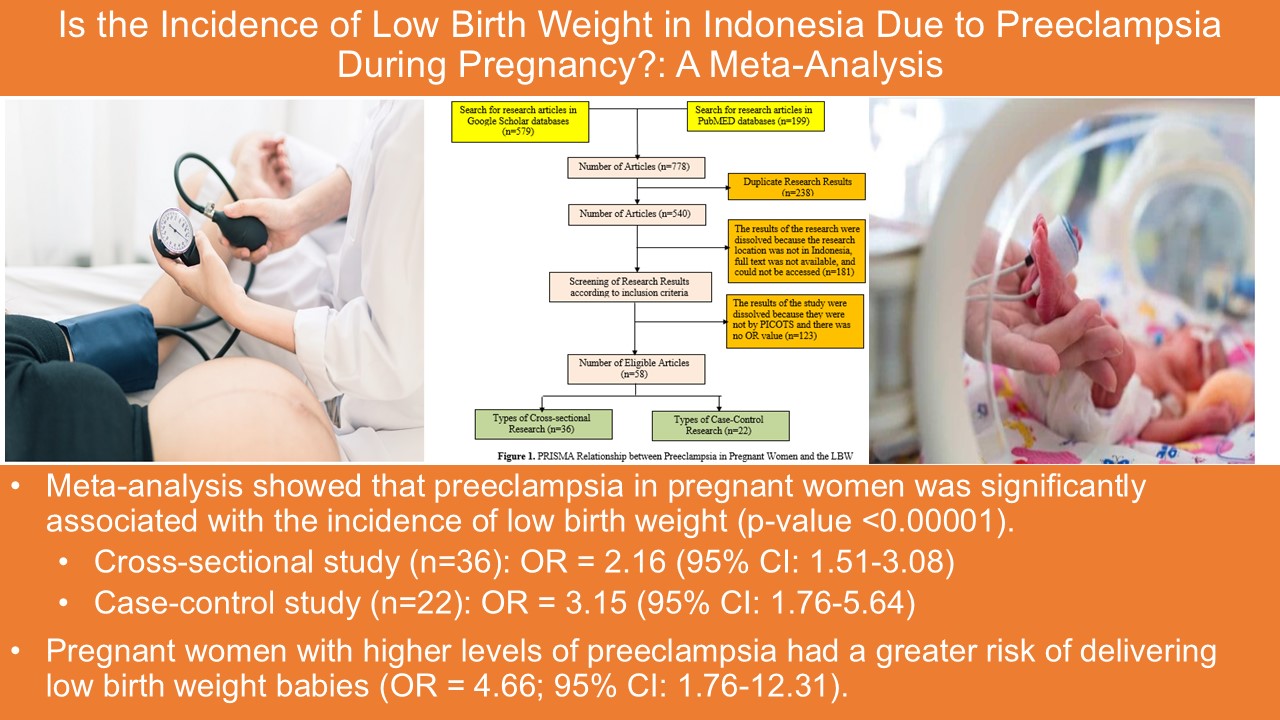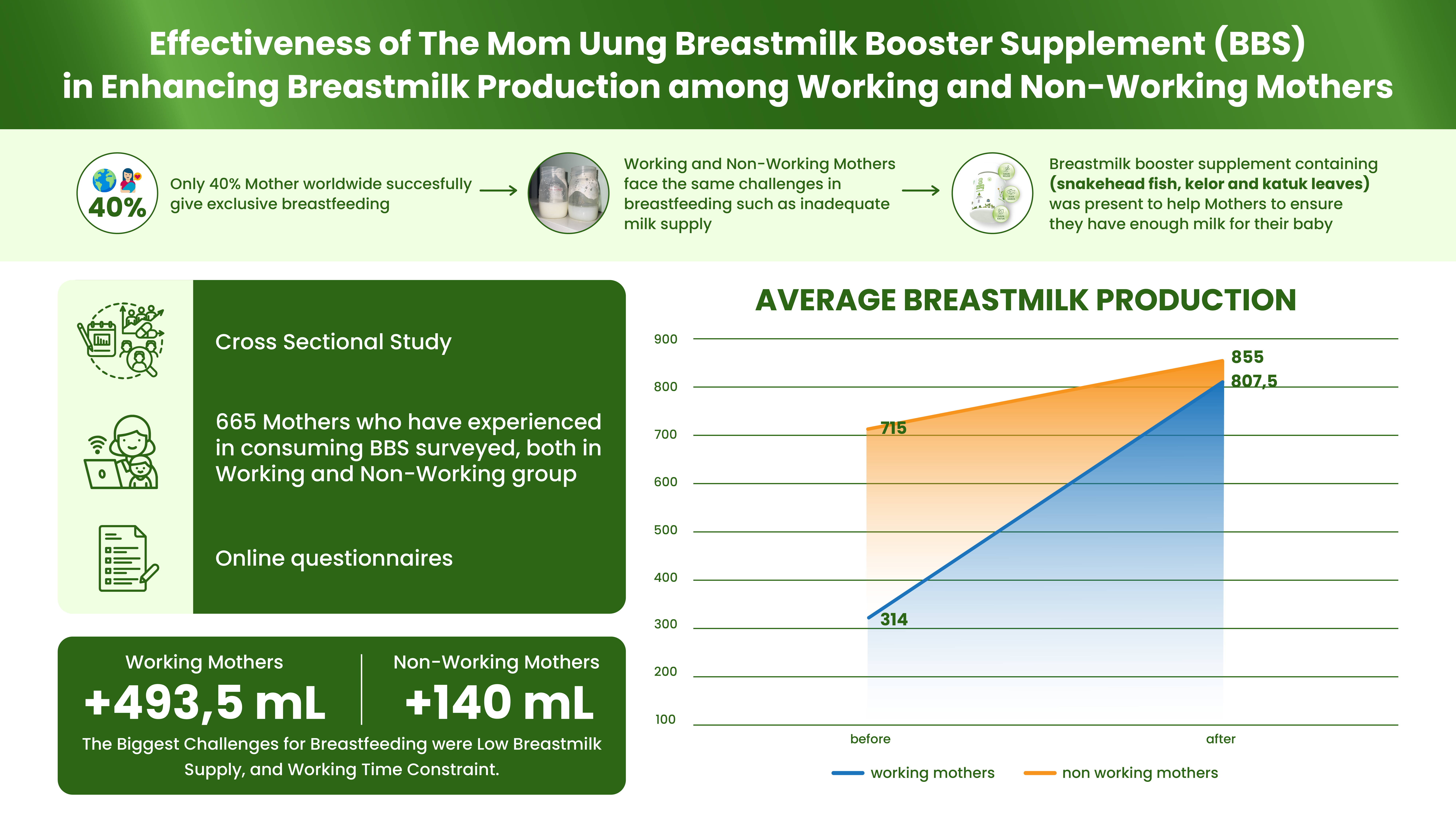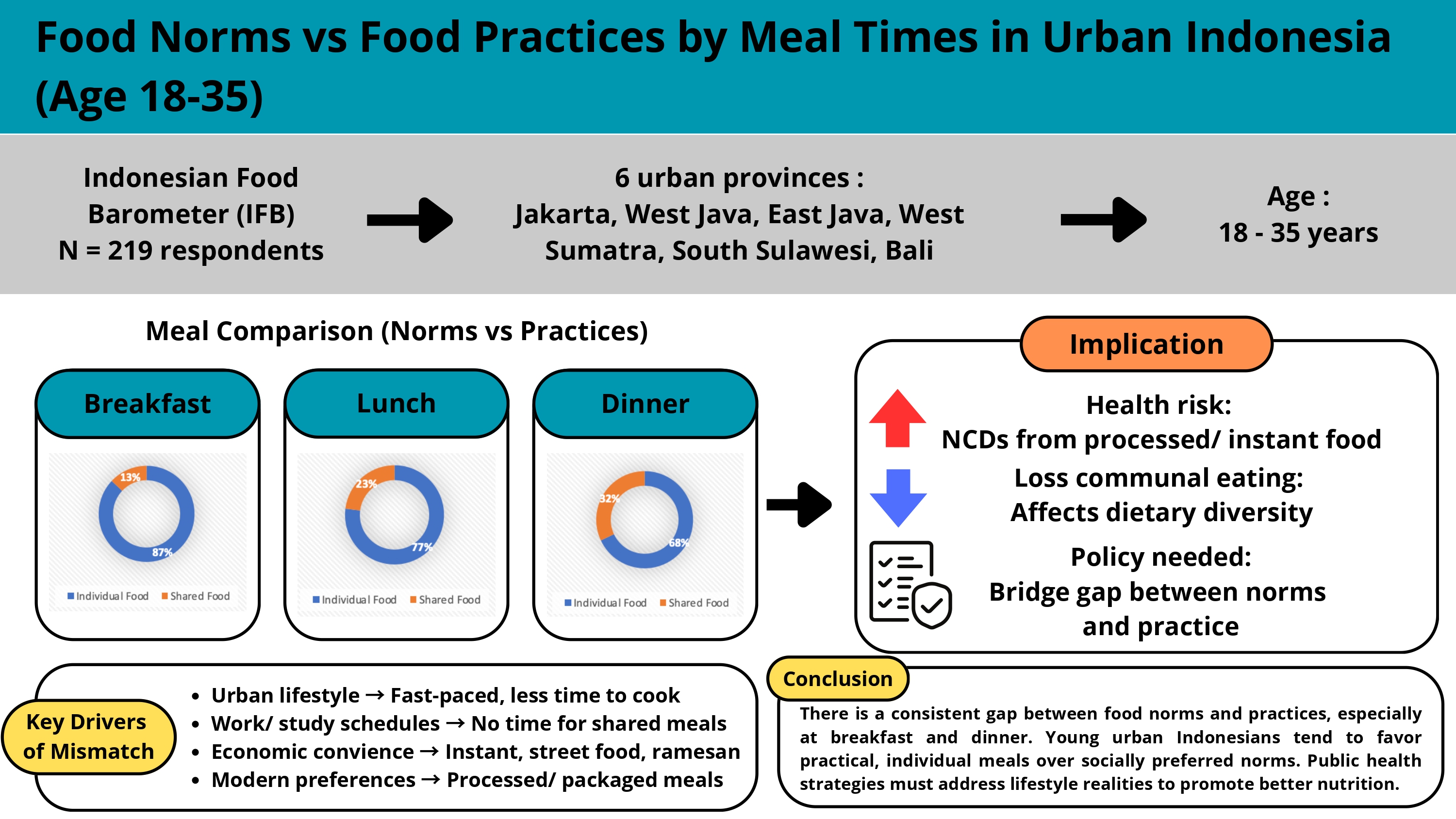DIETARY QUALITY AND NUTRITIONAL STATUS OF ADOLESCENTS IN RURAL AREAS OF SIGI REGENCY, INDONESIA

Downloads
Adolescence is a transitional period from childhood to adulthood, marked by various changes in different aspects of life. These changes can put adolescents at risk of experiencing nutritional problems. Central Sulawesi faces adolescent nutrition problems due to unhealthy eating patterns and a lack of dietary diversity. The nutritional status of adolescents in Central Sulawesi is also worse than the national average. Rural adolescents are thinner than urban adolescents because they have lower intake of energy, protein, and fat. Place of residence indirectly affects nutritional status during adolescence. This research was conducted in the rural area of Sigi Regency using a random sampling method with 154 adolescents participating in the study. The Mean Adequacy Ratio (MAR) is used to assess diet quality, and BMI/U measurement is used to determine the nutritional status of adolescents. Overall, the diet quality is still low. A MAR score of 56.1% indicates that the nutritional intake of adolescents is not yet optimal, with protein, fat, and carbohydrates at adequate levels, but vitamins A, B1, and C, as well as B9 and B12, are still low, indicating a potential deficiency in the body. The percentage of thin and obese adolescents exceeds the national figures. There is no difference in MAR among nutritional statuses.Comprehensive nutritional interventions are needed to improve the still low diet quality and the still low nutritional status.
Amrynia SU, Prameswari GN. 2022. Hubungan Pola Makan, Sedentary Lifestyle, dan Durasi Tidur dengan Kejadian Gizi Lebih Pada Remaja (Studi Kasus di SMA Negeri 1 Demak). Indones J Pub Health Nutrit. 2(1): 112–121. https://doi.org/10.15294/ijphn.v2i1.52044
Buanasita A, Hatijah N. (2022). Relationship between Food Pattern, Physical Activity, Internet Addiction with Nutrition Status of Senior High School Student during Covid-19 Pandemic in Surabaya. Amerta Nutrit. 6(1): 107–116. https://doi.org/10.20473/amnt.v6iSP.2022.107
Carbine, K. A., Larson, M. J., Romney, L., Bailey, B. W., Tucker, L. A., Christensen, W. F., & LeCheminant, J. D. (2017). Disparity in neural and subjective responses to food images in women with obesity and normal-weight women. Obesity, 25(2), 384–390. https://doi.org/10.1002/oby.21710
Dewi, N. U., Khomsan, A., Dwiriani, C. M., Riyadi, H., Ekayanti, I., Hartini, D. A., & Aiman, U. (2022). The Mean Adequacy Ratio and Balanced Nutrition Index (IGS) In Adolescents Living in The Post-Disaster Suburban Area. ALHAMDIC: Alauddin Health and Medical Conference.
Fakhirah, A. G., Hidayah, L., Rahayu, A., Rahmadaniah, D., Nisa, K., Aisyah, S., … Rahmat Santoso, B. (2023). Program Pengintar (Pentingnya Gizi Terhadap Remaja) di Smpn 22 Kota Banjarmasin Kalimantan Selatan. JSIM, 5(2), 55–63.
Ferozi, S., Taneja, A. G., & Bakshi, N. (2024). Assessment of nutritional status, physical fitness and physical activity of school going adolescents (12–15 years) in Delhi. BMC Pediatrics, 24(1), 331. https://doi.org/10.1186/s12887-024-04733-y
Fundo, J. F., & Silva, C. L. M. (2018). 2 - Microstructure, composition and their relationship with molecular mobility, food quality and stability. In S. B. T.-F. M. and I. R. with Q. and S. Devahastin (Ed.), Woodhead Publishing Series in Food Science, Technology and Nutrition (pp. 29–41). Woodhead Publishing. https://doi.org/https://doi.org/10.1016/B978-0-08-100764-8.00002-2
Horiuchi, Y., Kusama, K., Kanha, S., & Yoshiike, N. (2019). Urban-rural differences in nutritional status and dietary intakes of school-aged children in Cambodia. Nutrients, 11(1). https://doi.org/10.3390/nu11010014
Howes, E. M., Parker, M. K., Misyak, S. A., DiFeliceantonio, A. G., Davy, B. M., Brown, L. E., & Hedrick, V. E. (2024). The Impact of Weight Bias and Stigma on the 24 h Dietary Recall Process in Adults with Overweight and Obesity: A Pilot Study. Nutrients, Vol. 16. https://doi.org/10.3390/nu16020191
Kamaruddin, I., Kustiyah, L., Riyadi, H., & Junus, R. (2023). Faktor-Faktor Yang Mempengaruhi Status Gizi Pada Remaja Overweight dan Obese. Amerta Nutrition, 7(2), 311–319.
Kasiaradja, A., Anas Anasiru, M., Labatjo, R., Bulan Febry, A. K., Gizi, J., Kemenkes Gorontalo, P., & Gorontalo, K. (2022). Gambaran Kebiasaan Makan dan Status Gizi pada Remaja Usia 12-17 Tahun. Journal Health and Nutritions, 8(1), 21–28.
Kemenkes RI. (2023). Survei Kesehatan Indonesia Tahun 2023 (Dalam Angka).
Kristianti, Y. D., & Metere, S. (2021). Hubungan Pengetahuan Remaja Putri Tentang Anemia dan Sikap Remaja Terhadap Konsumsi Suplemen Zat Besi di SMAN Wilayah Jakarta Timur. Jurnal Ilmiah Gizi Kesehatan, 9.
Labatjo, R. (2024). Pelatihan Edukator Sebaya Sebagai Upaya Pencegahan Masalah Gizi Pada Remaja. JMM (Jurnal Masyarakat Mandiri), 8(1), 976. https://doi.org/10.31764/jmm.v8i1.20300
Maslakhah, N. M., & Prameswari, G. N. (2022). Pengetahuan Gizi, Kebiasaan Makan, dan Kebiasaan Olahraga dengan Status Gizi Lebih Remaja Putri Usia 16-18 Tahun. Indonesian Journal of Public Health and Nutrition, 2(1), 52–59. https://doi.org/10.15294/ijphn.v2i1.52200
Monge-Rojas, R., Vargas-Quesada, R., & Gómez, G. (2022). Role of Residence Area on Diet Diversity and Micronutrient Intake Adequacy in Urban and Rural Costa Rican Adolescents. Nutrients, Vol. 14. https://doi.org/10.3390/nu14235093
Musfira, M., & Hadju, V. (2024). Nutrition and Dietary Intake of Adolescent Girls in Indonesia: A Systematic Review. Scripta Medica (Banja Luka), 55(4), 473–487. https://doi.org/10.5937/scriptamed55-49461
Phillips, C. M. (2013). Nutrigenetics and metabolic disease: current status and implications for personalised nutrition. Nutrients, 5(1), 32–57. https://doi.org/10.3390/nu5010032
Popkin, B. M., & Ng, S. W. (2022). The nutrition transition to a stage of high obesity and noncommunicable disease prevalence dominated by ultra-processed foods is not inevitable. Obesity Reviews : An Official Journal of the International Association for the Study of Obesity, 23(1), e13366. https://doi.org/10.1111/obr.13366
Prynn, J. E., Banda, L., Amberbir, A., Price, A. J., Kayuni, N., Jaffar, S., … Nyirenda, M. (2018). Dietary sodium intake in urban and rural Malawi, and directions for future interventions. The American Journal of Clinical Nutrition, 108(3), 587–593. https://doi.org/https://doi.org/10.1093/ajcn/nqy125
Sari, P., Azizah, D. I., Gumilang, L., Judistiani, R. T. D., & Mandiri, A. (2020). Asupan Zat Besi, Asam Folat, dan Vitamin C pada Remaja Putri di Daerah Jatinangor. Jurnal Kesehatan Vokasional, 4(4), 169. https://doi.org/10.22146/jkesvo.46425
Sari, P., Herawati, D. M. D., Dhamayanti, M., & Hilmanto, D. (2022). The Study of Nutrient Intake and Adolescent Girls’ Quality of Life in a Rural Area of Indonesia. Children (Basel, Switzerland), 9(8). https://doi.org/10.3390/children9081248
Shah, K., Shah, H., Vijan, S., Kamat, S., Kirpalani, D., & Kirpalani, A. (2022). THE SALT STUDY - SALT INTAKE IN ADOLESCENTS TODAY. Journal of Hypertension, 40(Suppl 1).
Sisay, B. G., Lacy, K. E., McNaughton, S. A., & Leech, R. M. (2024). Comparison of snack characteristics by diet quality findings from a nationally representative study of Australian adolescents. Scientific Reports, 14(1), 23663. https://doi.org/10.1038/s41598-024-75386-1
Vidyarini, A., & Ayunin, E. N. (2022). Keragaman dan kualitas konsumsi pangan pada remaja usia 15–17 tahun. ARGIPA (Arsip Gizi Dan Pangan), 7(1), 31–39. https://doi.org/10.22236/argipa.v7i1.7951
Wasudewa, A. A. N. G., Nadifa, N., Khakim, L., Ayu, N., Roosyidah, N., Prahestin, N., … Yasmin, H. F. (2021). Indeks Ketahanan Pangan (IKP) Provinsi Sulawesi Tengah Tahun 2020. Dialistik Media Analisis Statistik, 01(01).
Wiafe, M. A., Apprey, C., & Annan, R. A. (2023). Dietary Diversity and Nutritional Status of Adolescents in Rural Ghana. Nutrition and Metabolic Insights, 16, 11786388231158488. https://doi.org/10.1177/11786388231158487

This work is licensed under a Creative Commons Attribution-NonCommercial-ShareAlike 4.0 International License.
- MEDIA GIZI INDONESIA Journal is the copyright owner of all materials published on this website.
- The formal legal provisions for access to digital articles of this electronic journal are subject to the terms of the Creative Commons Attribution-NonCommercial-ShareAlike license (CC BY-NC-SA 4.0), which means that MEDIA GIZI INDONESIA Journal and readers reserve the right to save, transmit media / format, manage in database, maintain, and publish articles as long as it continues to include the name of the Author.
- Printed and published print and electronic manuscripts are open access for educational, research and library purposes. In addition to these objectives, the editorial board shall not be liable for violations of copyright law.


2.png)





















